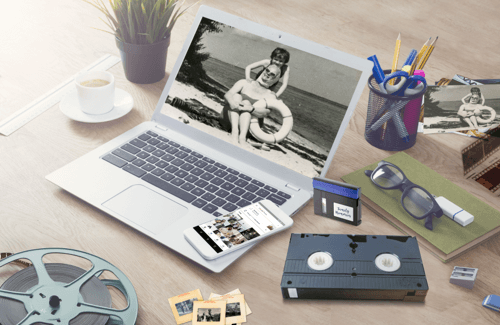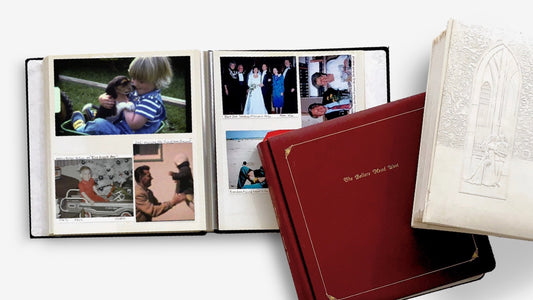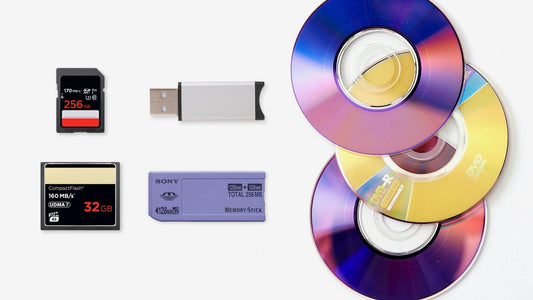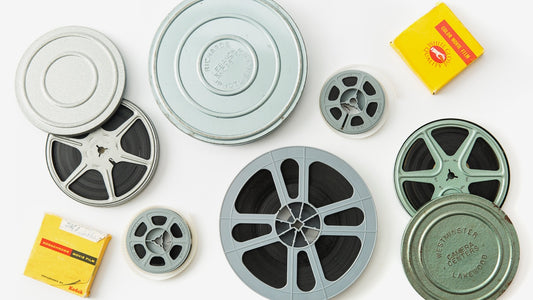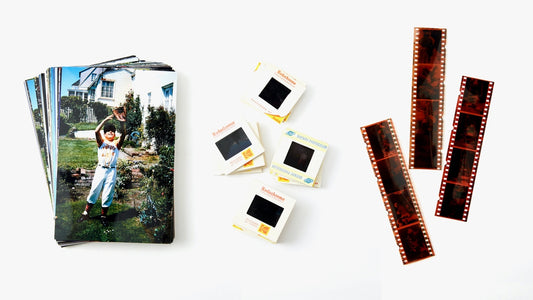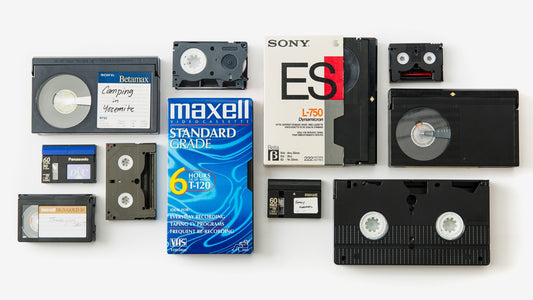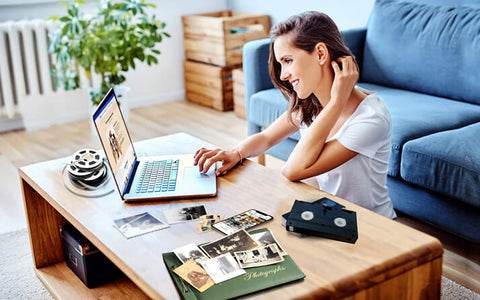Your home movies are more than just old tapes. They're a visual record of your family's story—the moments you'll want to share for generations. But those physical tapes are fragile. They decay, get damaged, and can be lost forever. To protect these memories, you need to convert VCR tapes to a digital format. This creates a lasting family archive that's safe, secure, and easy to share. I'll walk you through the best ways to preserve your legacy, comparing the quality, cost, and effort of each method so you can make the right choice for your family.
Key Takeaways
- Act Before Your Tapes Fade: The magnetic tape in your VCR cassettes degrades over time, meaning the picture and sound quality of your memories are slowly disappearing. Digitizing is the only way to permanently preserve these moments before they are lost for good.
- Pick the Right Path for You: Your best conversion method depends on your goals. A DIY setup offers control if you have the time and tech skills, while a professional service like YesVideo guarantees high-quality, hassle-free results, especially for large or delicate collections.
- Protect and Share Your New Digital Files: Once your memories are digitized, create a backup plan by storing them on both a physical hard drive and a cloud service. This ensures your family’s history is safe and makes it easy to edit and share with loved ones anywhere.
Why Should You Convert Your VCR Tapes?
Those stacks of VCR tapes tucked away in your attic or basement are holding onto some of your most precious memories—first steps, birthday parties, and holiday gatherings with loved ones. But the magnetic tape inside those cassettes wasn't designed to last forever. Over time, tapes degrade, colors fade, and the audio can become distorted. This natural decay means your memories are at risk of disappearing completely. The only way to stop the clock is to digitize them. A professional video transfer is the safest way to preserve those moments before they're lost for good.
Beyond preservation, think about how much easier it is to enjoy and share digital files. Finding a working VCR these days can be a project in itself, let alone hooking it up to a modern TV. When your home movies are converted to a digital format, you can watch them on your computer, phone, or smart TV with a simple click. Imagine being able to instantly send a clip of your childhood birthday party to your siblings or post a sweet memory of your parents on their anniversary. Digitizing brings your memories into the present, making them easy to relive and share with anyone, anywhere.
Finally, digitizing gives you peace of mind. Physical tapes are vulnerable to everything from house fires and floods to simply being misplaced during a move. A single accident could wipe out an entire collection. Digital files, however, can be backed up in multiple places. You can store them in the cloud, on an external hard drive, and on your computer, ensuring your family’s history is safe from physical damage. It’s about creating a secure, lasting archive so that future generations can enjoy these moments, too.
The Lifespan of a VHS Tape
It’s a tough reality to face, but the VHS tapes holding your family's history have an expiration date. The magnetic tape inside begins to break down after about 15 years, causing the picture to get fuzzy, colors to fade, and audio to become distorted. This isn't just simple wear and tear; it's the slow, irreversible decay of the medium itself, meaning your memories are literally disappearing. Beyond natural decay, physical tapes are also susceptible to heat, humidity, and accidents like fires or floods. The only way to truly safeguard these moments is through a video transfer, which creates a permanent digital copy that won't fade or fall apart, ensuring your family's story is protected for generations to come.
The Best Ways to Convert VCR Tapes to Digital
When you decide to digitize your VCR tapes, you have a few solid paths you can take. The best choice for you really comes down to your budget, how much time you have, and how comfortable you are with technology. Think of it as choosing between a DIY project, hiring a specialist, or finding a middle-of-the-road solution. Each option will get you to the finish line—a digital copy of your precious memories—but the journey will look a little different. Let's walk through the top three methods so you can pick the one that feels right.
The DIY Method: Converting Tapes Yourself
If you enjoy a hands-on project and have some patience, the DIY route might be for you. This process involves connecting your old VCR to a video capture device using RCA cables (the red, white, and yellow ones). The capture device then plugs into your computer and converts the analog signal from the tape into a digital file, like an MP4. You'll need a working VCR and the right capture hardware and software. While this gives you full control over the process, it can be time-consuming, especially if you have a lot of tapes. You might also run into technical hiccups or find the final quality isn't quite what you hoped for.
The Pro Method: Using a Professional Service
For a completely worry-free experience, handing your tapes over to a professional conversion service is the way to go. This is the perfect option if you're short on time, not very tech-savvy, or simply want the best possible quality without any of the hassle. Experts use professional-grade equipment that can often produce a better digital file than consumer-level devices. They can also handle repairs for damaged tapes and ensure every memory is preserved safely. You just pack up your tapes, send them in, and wait for your new digital files to arrive, ready for sharing and enjoying with your family for years to come.
The Simple Method: Using a Direct-to-DVD Recorder
A third option is to use a combination VHS-to-DVD recorder. These all-in-one machines were popular for a reason—they make it incredibly simple to copy a VHS tape directly onto a blank DVD. You just pop in the tape and a disc and press record. The main drawback is that you end up with a DVD, which is still a physical format that can degrade over time. To get a true digital file, you’ll need to complete an extra step: "ripping" the video from the DVD onto your computer using software. While it’s more straightforward than the full DIY capture card method, it’s a two-step process to get your videos into a shareable format.
Other Local and Short-Term Options
If the main methods don't feel like the right fit, you still have a couple of other avenues to explore. These options are often best for very specific situations, like if you only have one or two tapes or want to try a hands-on approach without buying all the equipment. They can be great solutions, but it’s important to understand their limitations. Think of these as specialized tools in your memory-preservation toolkit—useful for the right job, but not always the most comprehensive solution for an entire collection of family history. Let's look at when hiring a local pro or renting gear might make sense for you.
Hiring a Local Videographer
If you prefer a face-to-face interaction, you might consider hiring a local videographer. Many independent video professionals offer digitization as a side service, and it can feel reassuring to hand your precious tapes to someone in your own community. This can be a solid choice if you only have a couple of tapes and want a personal touch. However, keep in mind that quality and expertise can vary widely from one person to another. A local videographer may not have the same specialized, professional-grade equipment that a dedicated video transfer service uses, which is designed to get the best possible picture and sound from aging tapes.
Renting Conversion Equipment
For those who are curious about the DIY method but hesitant to purchase equipment you’ll only use once, renting a video capture device is another possibility. Some electronics stores offer rental services, allowing you to tackle the project yourself for a short period. This gives you control over the process without the long-term investment. Be prepared, though—this is still a DIY project that requires your time and a certain level of technical comfort. You'll be responsible for the entire conversion process, and the final quality will depend on the rented gear and your own skill. If your goal is a high-quality, hassle-free result, a professional service that handles everything for you is often the more reliable path.
The Best Tools and Services for VHS Conversion
Once you’ve decided on your approach, it’s time to look at the specific tools and services that can get the job done. This is where your planning turns into action. Whether you’re rolling up your sleeves to tackle this project yourself or feel more comfortable handing your tapes off to an expert, knowing your options will help you make the best choice for your precious home movies. Think of this as choosing your toolkit for the job. We’ll walk through the best hardware for DIY conversions, the software that can make your videos shine, and a comparison of the most trusted professional services out there.
Our Top Picks for Capture Devices and Converters
If you’re going the DIY route, a capture device is your most important piece of equipment. These handy gadgets act as a bridge between your old VCR and your modern computer. You simply connect the VCR to the capture device with RCA cables (the red, white, and yellow ones), and the device converts the analog signal into a digital file, like an MP4. Many popular devices allow you to record directly to your computer, while others let you record to an SD card or USB drive, which means you don’t even need a computer for the transfer. For an even simpler process, some all-in-one converters include a small screen so you can preview your video as it records.
Standalone Converters (No Computer Needed)
If the thought of installing software or messing with computer settings sounds like a headache, a standalone converter is your best friend. These devices are designed for simplicity. You connect your VCR directly to the converter box using the standard red, white, and yellow RCA cables, insert an SD card or USB flash drive, and press record. Many of these converters, like the popular ClearClick Video to Digital Converter 2.0, even have a small built-in screen so you can watch your home movie as it transfers. It’s a self-contained solution that completely removes the computer from the recording process, making it one of the most straightforward ways to digitize your tapes at home.
Computer-Based Capture Cards
For those who are comfortable working on a computer and want more control over the final video file, a computer-based capture card is a great option. This small device acts as a bridge, connecting your VCR to your computer’s USB port. From there, you’ll use software to record the video as it plays. While this requires a bit more setup, it’s often a cost-effective way to convert a large collection of tapes. You can use free, powerful software like Open Broadcaster Software (OBS) to capture the video, giving you control over settings like resolution and file format. Popular capture devices from brands like Elgato are known for their reliability and quality, making this a solid choice for the tech-savvy DIYer.
Top Software for Editing Your Digitized Videos
After you’ve converted your tapes, you might notice the footage could use a little touching up. This is where editing software comes in, and you don’t need to be a professional to make simple improvements. Free programs are perfect for this. For example, HandBrake is a fantastic tool for compressing your new digital files to a more manageable size without losing quality. If you want to trim unwanted sections or make minor adjustments to the color or sound, a program like OBS Studio is another powerful, no-cost option. Taking a few extra minutes to edit can make your old home movies look and feel much more polished and ready to share.
All-in-One Software Suites
If you want to take your editing a step further, an all-in-one software suite can be a fantastic investment. These programs bundle powerful editing tools into one user-friendly package, so you can trim clips, fix colors, and even add music without juggling multiple applications. For example, Adobe Premiere Elements is a popular choice because its guided edits walk you through the process, making it easy to create a polished video. Another excellent option is CyberLink PowerDirector, which offers more advanced features like motion tracking if you feel like getting creative. For something with a super intuitive interface, check out Filmora; it’s known for its simple drag-and-drop editing and library of royalty-free music. Using one of these suites can help you turn your digitized home movies into beautiful keepsakes ready to be shared.
Comparing the Top Professional Digitizing Services
Feeling a bit overwhelmed by the technical side of things? That’s completely understandable. If you’d rather not spend your weekend untangling cables and troubleshooting software, a professional conversion service is an excellent choice. These companies have the high-end equipment and expertise to handle your tapes with care, often delivering a higher-quality result than you could achieve at home. Here are a few of the most popular options.
YesVideo
With over 20 years of experience, we’ve helped millions of families preserve their memories. As the world’s largest and most trusted digitization service, we handle every order by hand right here in the USA. We can convert not just VHS tapes but also film reels, photos, and more. Our process ensures your memories are safe and the final digital files are something your family will treasure for generations. You can learn more about our video transfer service on our website.
Legacybox
Legacybox is another popular mail-in service that digitizes a wide range of media. They send you a kit to fill with your items, and you can choose the size based on how many tapes or photos you have. They convert your media to digital formats and send everything back to you, including your original tapes.
Legacybox: The All-in-One Kit Approach
Legacybox is known for its all-in-one kit, which simplifies the process of digitizing your media. They mail you a crush-proof box with a pre-paid shipping label, and you just fill it with your VHS tapes, film reels, photos, or other old formats. After you send it off, their team in the USA carefully converts everything by hand, keeping you in the loop with email updates along the way. Once the work is done, they send all your original items back, along with your new digital copies. You can choose to get your memories on a thumb drive, DVDs, or as a digital download, giving you plenty of options for watching and sharing. The service is designed to be a straightforward, worry-free way to protect your family’s history from the natural decay of old tapes.
Costco Photo Center
Many people don’t realize that Costco offers a media conversion service through their Photo Center. You can drop off your VHS tapes and have them converted to a digital format. It’s a convenient option if you’re a Costco member and prefer to handle the drop-off and pickup in person at a local store.
Walmart Photo
Similar to Costco, Walmart Photo provides a VHS to digital conversion service. This is another accessible option for those who want the convenience of using a familiar big-box retailer. You can bring your tapes to the photo department to start the process of preserving your home movies.
CVS Photo
CVS Photo also provides a home movie transfer service, converting old media like VHS tapes and film reels into digital formats such as DVDs and USB drives. It’s a straightforward service available at thousands of locations, making it an easy choice for many.
Walmart Photo: Cloud Access and Customization
Similar to Costco, Walmart Photo offers a VHS to digital conversion service, making it another accessible option if you prefer using a familiar retailer. The process is straightforward: you can bring your tapes directly to the photo department to get started on preserving your home movies. They partner with a third-party service to handle the actual conversion, so your tapes will be sent out for processing. Once digitized, you get access to your memories through a cloud account, which makes it easy to view and share them online. This is a solid choice for anyone who values the convenience of in-person drop-off at a store they already frequent.
CVS Photo: Convenient In-Store Drop-Off
CVS Photo also provides a home movie transfer service, turning old media like VHS tapes and film reels into digital files on a DVD or USB drive. With thousands of locations, it’s an incredibly convenient option for many families. You can simply drop off your tapes while you’re already in the store. Like Walmart, CVS uses a partner company to perform the digitization, so your memories are sent to an off-site facility for conversion. It’s a simple, no-fuss service if your main priority is finding a local drop-off point and you don't mind the handoff to another vendor for the actual work.
DIY vs. Professional: Which Is Right for You?
Deciding between converting your VCR tapes yourself or handing them over to a professional service can feel like a big choice. There’s no single right answer—it really comes down to what you value most. Are you looking for the highest possible quality, do you want to save time, or is sticking to a specific budget your top priority? Let's walk through the key differences to help you figure out the best path for preserving your precious memories.
Video Quality: DIY vs. Pro
When you convert tapes at home, the final video quality depends entirely on your setup. The condition of your VCR, the quality of your analog-to-digital capture device, and the software you use all play a major role. The quality of the conversion process is only as good as the data you feed into it, which means your equipment and the original tape's condition are critical. A worn-out VCR or a cheap converter can result in a digital file that’s fuzzy, distorted, or has poor color.
Professional services, on the other hand, use commercial-grade, calibrated equipment designed specifically for high-quality transfers. At YesVideo, our technicians manually process every tape, cleaning them and monitoring the transfer to ensure the best possible outcome. This professional touch makes a noticeable difference, especially for older or more delicate tapes. Our video transfer process is designed to capture every detail with clarity.
How Much Time and Effort Is Required?
The DIY route requires a significant time investment. First, you have to research and purchase the right equipment. Then, you’ll need to set it all up and learn the software. The conversion itself happens in real-time, meaning a three-hour tape takes three hours to capture. If you have a large collection, this can quickly turn into a project that spans weeks or even months. You also have to document the specific steps required and troubleshoot any technical glitches that pop up along the way.
Using a professional service like YesVideo is the hands-off approach. Your main job is to gather your tapes and send them in. We handle the entire conversion process, from cleaning and digitizing to organizing your files on a thumb drive, DVD, or in the cloud. This frees you up to focus on the fun part: planning how you’ll share these rediscovered memories with your family.
The Real-Time Commitment of DIY Conversion
One of the biggest realities of DIY conversion is that it happens in real-time. Unlike copying a digital file, you have to play each tape from beginning to end for the computer to capture the footage. This means a two-hour tape takes two hours to digitize—and that’s just the recording part. It doesn’t account for the time you’ll spend researching and setting up the equipment, or troubleshooting the inevitable technical hiccups that can pop up. If you have a collection of 15 tapes, you’re looking at over 30 hours of hands-on work. This is often the point where a fun project starts to feel like a chore, which is why many people choose to send their tapes to a professional service instead.
Cost Comparison: DIY vs. Professional
At first glance, the DIY method might seem cheaper. You buy the equipment once and can convert as many tapes as you want. A decent setup can cost anywhere from $50 to over $200. However, it's important to consider the hidden costs. You’re investing your time, which has value. There’s also the risk of damaging your one-of-a-kind tapes if something goes wrong. Properly evaluating the source data is key to preventing data loss, a step that can be tricky without experience.
Professional services have a clear per-tape or per-hour cost. While this can add up for large collections, you’re paying for expertise, convenience, and peace of mind. You get high-quality results without the learning curve or the risk of damaging your tapes. Services like our film transfer and photo scanning provide a secure, reliable way to preserve your entire family archive, not just your videotapes.
A Breakdown of Professional Service Costs
When you start looking at professional services, it’s helpful to understand what you’re paying for. The cost isn’t just for the final digital file; it’s for the expertise, the high-end equipment, and the peace of mind that comes with knowing your irreplaceable tapes are being handled carefully. Companies often charge per tape or based on the length of the footage. While the initial price tag might seem higher than a DIY setup, the convenience and quality results often make it a worthwhile investment for preserving your family’s most important moments.
Many services offer competitive pricing. For instance, Walmart Photo provides a VHS to digital conversion service that starts at around $13 for the first 30 minutes of footage, with the price increasing for longer tapes. Similarly, CVS Photo offers a straightforward home movie transfer service at thousands of its stores, making it a very convenient option for in-person drop-offs. These services are great if you value accessibility and have just a few tapes to convert.
Another popular option is Legacybox, which sends you a kit to fill with your media. Their pricing is based on the number of items you want to digitize, and their mail-in service is designed to handle a wide range of formats. For those who prioritize a trusted, specialized touch, a service like ours at YesVideo is built on decades of experience. We are recognized as one of the largest and most trusted digitization services because we handle every order by hand in the USA, ensuring your memories receive the highest level of care and quality.
What to Look for in a VHS-to-Digital Converter
If you’ve decided to go the DIY route, choosing the right VHS-to-digital converter is the most critical step. The market is full of options, and the quality can vary dramatically. The right tool can make this a fun, rewarding project, while the wrong one can lead to hours of frustration and poor-quality video. Think of this as buying any other piece of tech—you want features that make your life easier and give you the best possible outcome.
Before you buy, it’s helpful to understand what separates a great converter from a mediocre one. Key features can help you capture your memories clearly, streamline the process, and avoid common technical headaches. While the DIY path gives you full control, it also makes you the quality control manager. Paying attention to a few specific details will ensure your final digital files are something you’re proud to share. If this process starts to feel overwhelming, remember that a professional video transfer service handles all of these technical details for you, ensuring a high-quality result without the guesswork.
First, Check for Format Compatibility
First things first, make sure the converter you choose can actually handle your tapes. While "VHS" is often used as a catch-all term, you might have other formats in your collection, like VHS-C (the smaller tapes used in camcorders), S-VHS, or even Video8. Check the labels on your tapes and the product description of the converter carefully. Beyond the physical tape, you also need to consider digital compatibility. The device should create files that are easy to use on your computer. As experts in data conversion note, it's crucial to analyze a source's compatibility with the target system to ensure a smooth transfer.
Common Tape Formats We Digitize
If the thought of figuring out different tape types and converters makes your head spin, you're not alone. It's easy to feel overwhelmed when you start digging through your collection and realize you have more than just standard VHS tapes. You might find smaller camcorder tapes like VHS-C, Hi8, or MiniDV mixed in with the rest. This is where a professional service can be a huge relief. At YesVideo, we have the specialized equipment to handle nearly any format you throw our way. We can digitize everything from VHS, VHS-C, and S-VHS to Hi8, Digital8, MiniDV, and even the rare Betamax tape. This means you don't have to worry about compatibility—we'll make sure every memory is preserved with care, no matter what kind of tape it’s on.
Why You Need a Built-in Preview Screen
A converter with a small, built-in LCD screen is incredibly useful. This feature lets you watch the video as it’s being recorded, so you can monitor the quality in real time. You can immediately spot any issues like tracking errors (the fuzzy lines at the top or bottom of the screen), audio problems, or long stretches of blank tape. This allows you to be proactive about quality instead of discovering a problem hours later. As the National Archives guide on digitization points out, a proactive approach is always better than relying on inspection after the fact. A preview screen helps you do just that, saving you from having to re-digitize an entire tape.
Prioritize Direct Recording Capabilities
For the simplest, most straightforward conversion, look for a device that can record directly to an SD card or USB flash drive. This feature completely bypasses the need for a computer during the capture process. You simply plug in your VCR, connect the converter, insert a memory card, and press record. This setup minimizes the potential for software crashes or computer-related glitches that can interrupt the transfer. The quality of your final video is heavily dependent on a clean capture process, so simplifying the data collection and preprocessing steps is a huge advantage, especially if you aren't very tech-savvy.
Choose User-Friendly Software
If your converter requires a computer to capture and save the video, the included software is a major part of the package. Unfortunately, many converters come bundled with software that is outdated, confusing, or difficult to install. Before buying, read reviews that specifically mention the software experience. Look for a program with a clean, intuitive interface and clear instructions. The goal is to make the process easier, not add a technical learning curve. Ultimately, the point of conversion is to get a result that meets your expectations, and wrestling with bad software can quickly sour the entire project.
Look for Adjustable Quality Settings
Having some control over the final video quality is a great feature. Some converters allow you to choose between different resolution or bitrate settings. A higher-quality setting will result in a crisper image but will also create a much larger file size. A lower-quality setting will save space on your hard drive but might look less sharp. This flexibility lets you make the right trade-off for your needs. It’s a way to manage the constraints or limitations of the project, whether your main concern is achieving the best possible picture or simply saving dozens of tapes without filling up your computer’s storage.
Troubleshooting Common Conversion Problems
When you pull out a box of old VCR tapes, you might find they aren’t all in perfect shape. Decades in storage can lead to everything from cracked cases to faded picture quality. While some issues are minor, others can put your memories at risk if handled improperly. Here’s a look at some common problems and how you can approach them.
What to Do with Damaged Tapes
Before you pop a tape into a VCR, give it a good look. Is the plastic casing cracked or broken? Is the tape itself twisted, tangled, or showing signs of mold? While you might be able to fix a simple cracked case by carefully moving the reels to a new shell, more serious damage requires a delicate touch. Trying to clean mold or splice a snapped tape yourself can easily cause permanent harm. The final quality of your digital file depends entirely on the condition of the source tape. For precious memories on a damaged tape, consider a professional video transfer service. Experts have the proper tools to safely repair and digitize fragile media.
How to Fix Poor Audio and Video
Sometimes the tape is physically fine, but the playback quality is poor. You might see fuzzy lines, faded or distorted colors, and muffled audio. This is a natural part of how magnetic tapes age. If you’re converting tapes at home, your software may offer some basic filters to clean up the picture, but there’s only so much it can do. The quality of the conversion process is directly linked to the quality of the original tape. Professional services use high-end playback decks and processing equipment that can often produce a clearer, more stable picture than consumer-grade gear. Technicians can also make manual adjustments during the film transfer to optimize the audio and video from your specific tapes.
How to Fix Common Technical Glitches
Technical glitches like dropped frames, audio that doesn’t sync with the video, or weird digital artifacts can also pop up during conversion. If you’re going the DIY route, these issues often stem from an overworked computer, incorrect software settings, or a faulty capture device. A well-run digitization operation is proactive about quality control to prevent these problems from the start. Instead of just inspecting the file afterward, professionals use calibrated equipment and standardized workflows to ensure a smooth transfer. This focus on a quality process, whether for a photo transfer or a video conversion, is key to getting a clean digital file without the technical headaches.
How to Choose the Best Method for You
Deciding between a DIY project and a professional service can feel like a big commitment. The best choice really comes down to your specific situation. By thinking through a few key factors, you can figure out the perfect path for preserving your precious memories without the stress. Let’s walk through it.
First, Assess Your Tape Collection
Before you can pick a method, you need a clear picture of what you’re working with. Gather all your tapes and take a quick inventory. How many do you have? Are they all standard VHS tapes, or do you have a mix of formats like VHS-C, Hi8, or MiniDV? Also, take a look at their physical condition. Are any of the cases cracked, or do the tapes look dusty or damaged? The types of tapes you have and their condition will play a big role in your decision. A handful of well-kept tapes might be a fun weekend DIY project, but a large, varied, or damaged collection often benefits from professional care.
How Important Is Video Quality to You?
Think about what you want the final product to look like. While you can’t magically turn a grainy home movie into a 4K masterpiece, the conversion method directly impacts how well the original quality is preserved. Professional services use high-end equipment designed to get the best possible signal from your old tapes, often resulting in a clearer and more stable digital file. DIY methods can work well, but the quality depends entirely on your VCR, capture device, and software. If preserving every detail is your top priority, letting a professional service handle the transfer is usually the safest bet to ensure the best possible outcome.
Be Honest About Your Tech Skills
This is a judgment-free zone. Take a moment to think about your comfort level with technology. The DIY route involves connecting a VCR to a computer with specific cables, installing software, and troubleshooting any issues that pop up, like audio sync problems or dropped frames. If that sounds like a fun challenge, go for it! But if you’d rather avoid the technical hassle and just get your finished videos back, a professional service is the way to go. They handle all the technical work, so you can skip the setup and go straight to enjoying your memories.
Figure Out Your Budget
Finally, let’s talk about cost. At first glance, the DIY approach might seem cheaper, especially if you have a lot of tapes. You’ll have an upfront cost for the capture device and software, but then you can convert as many tapes as you want. However, don’t forget to factor in your time—it’s valuable! Professional services typically charge per tape or by the hour of footage. This can be more cost-effective for smaller collections and saves you a significant amount of time and effort. By having a clear idea of your budget and how you value your time, you can choose the option that makes the most financial sense for you.
Now What? How to Preserve and Share Your Digital Memories
Congratulations! You’ve successfully converted your VCR tapes and saved those precious moments from fading away. Now comes the best part: reliving and sharing them. But before you host a family movie night, it’s important to make sure your new digital files are safe, sound, and ready for their debut. Taking a few extra steps now will ensure these memories can be enjoyed for generations to come.
Where to Store Your Digital Files
Your newly digitized memories are priceless, so you don't want to risk losing them to a single hard drive failure. The safest approach is to use a mix of storage options. Think of it as not putting all your eggs in one basket. I recommend keeping at least two local copies—one on your computer's internal drive and another on an external hard drive. This gives you quick access whenever you want it.
For the ultimate peace of mind, add a cloud storage service to the mix. This creates an off-site backup, protecting your files from physical damage like fire or theft. Services like Google Drive, Dropbox, or Amazon Photos are great options. When you digitize with YesVideo, you get a complimentary MemoryCloud account for 90 days, making it easy to view and share your videos from anywhere.
Easy Edits to Improve Your Videos
You don’t need to be a Hollywood director to make your old home movies shine. A few simple edits can make a world of difference and turn a raw transfer into a polished, watchable story. Start by trimming the boring parts—like the five minutes of recording the ground or the shaky footage at the beginning and end of a clip. This alone makes your videos much more engaging.
Most computers come with free, user-friendly video editing software, like iMovie for Mac or the Photos app for Windows. You can use these tools to adjust brightness and contrast to make the picture clearer or add simple text titles to label events, dates, and people. It’s a small effort that adds a professional touch and helps future generations understand who and what they’re watching.
Fun Ways to Share Your Digitized Content
Now that your videos are preserved and polished, it’s time to share the joy. Instead of just sending a file, get creative! Host a family movie night and project the videos onto a big screen for a nostalgic trip down memory lane. You could also create themed highlight reels—like a "Best of the 90s Christmas" or a "Summer Vacation Supercut"—and share them with relatives who couldn't be there.
For family and friends who live far away, you can create a private, unlisted YouTube channel or use your cloud storage service to share videos online with a secure link. This lets everyone enjoy the memories without you having to email massive files. Services like YesVideo make this incredibly simple, allowing you to share directly from your online account. It’s a wonderful way to reconnect with loved ones over the moments that matter most.
Related Articles
- VCR to Digital: 2023 Guide to Converting Tapes – YesVideo
- Convert VCR to DVD: 2023 Guide + Best Converters – YesVideo
- VHS to DVD Transfer: Top Services & DIY Guide – YesVideo
- Convert 8mm Film to Digital Near Me: 6 Top Services – YesVideo
- Digitize Slides: The Ultimate 2025 How-To Guide – YesVideo
Frequently Asked Questions
What happens to my original tapes if I use a professional service? Any reputable digitization service will always return your original tapes along with your new digital copies. We understand that your physical tapes hold immense sentimental value, and our process is designed to treat them with the utmost care. Think of it as making a perfect copy, not a replacement. You get the best of both worlds: your original home movies back safely in your hands and modern digital files that are easy to watch and share.
I don't have a working VCR. Is the DIY method still an option for me? Finding a reliable, working VCR these days can be a real challenge, and buying a used one is often a gamble. The playback heads on old machines can be worn out, which can result in a lower-quality transfer or even damage your delicate tapes. While you could try to find one, the time and money spent might be better put toward a professional service that uses calibrated, high-end equipment to ensure a safe and high-quality conversion.
How much digital storage space should I expect my converted videos to take up? The file size of your new digital videos depends on the length of the tape and the quality of the conversion. As a general rule, you can expect a standard two-hour VHS tape to convert to a digital file that is around 3-4 gigabytes. If you have a large collection, it’s a good idea to plan for an external hard drive to store all your new files safely without filling up your computer’s main drive.
My tapes are really old and don't look great when I play them. Is it even possible to get good quality from them? While no conversion process can magically turn grainy footage into high-definition video, you might be surprised at the quality that can be recovered. Professional services use commercial-grade equipment that is far more advanced than the VCR you had in your living room. This gear is better at reading the magnetic signal on the tape, often resulting in a clearer, more stable picture with better color than you could get at home.
What's the difference between getting my videos on a thumb drive versus a cloud account? A thumb drive is a physical device that holds your video files, which is great for creating a local backup and easily plugging into a computer or smart TV. A cloud account gives you instant access to your memories from any device with an internet connection. It’s the perfect solution for securely sharing videos with family and friends, no matter where they live, and it acts as an excellent off-site backup to protect against loss or damage.





